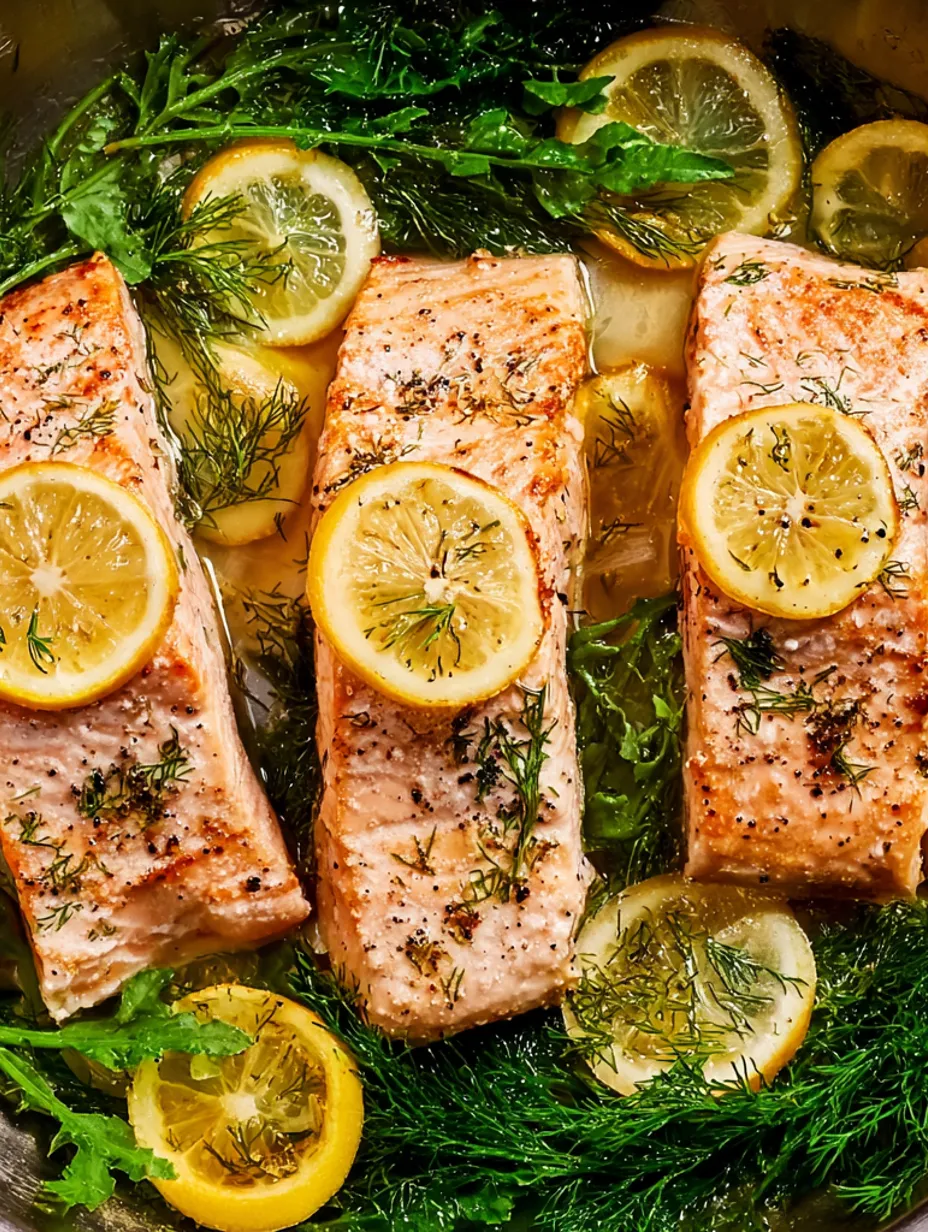 Bookmark
Bookmark
This moist flaky salmon is poached gently with white wine lemon and herbs to lock in flavor and tenderness. It is a restaurant style dish that is easy enough for a weeknight and elegant enough for company. Cooking it at home takes only 15 minutes and always delivers that delicate melt in your mouth texture I fell in love with the first time I tried it at a seaside restaurant.
I fell in love with this method the first time I recreated it and it is now a go to dish I make when I need something quick but impressive.
Ingredients
- Salmon fillets: fresh thick cuts with skin on help retain moisture
- Dry white wine: adds gentle acidity and depth to the poaching liquid
- Water: helps balance the strength of the wine while maintaining flavor
- Sea salt: seasons the poaching liquid and enhances natural fish flavor
- Shallot: offers sweet mild onion notes that do not overpower
- Lemon: sliced thin adds brightness and freshness to every bite
- Garlic: chopped for that savory aromatic backbone
- Fresh dill and parsley: bring herbaceous contrast and freshness
- Fresh cracked pepper: finishes the dish with a bit of bite
Step-by-Step Instructions
- Sauté the Aromatics:
- Lay sliced shallots garlic lemon dill and parsley in a single layer in a large stainless steel sauté pan. This forms the foundation of flavor that infuses the salmon.
- Make the Poaching Liquid:
- Combine white wine water and sea salt in a bowl. Pour gently over the layered aromatics ensuring they are mostly submerged but not floating.
- Bring to a Simmer:
- Set the pan over medium heat and watch closely as the liquid gently simmers. Avoid boiling to maintain the delicate nature of the salmon.
- Add the Salmon:
- Place the fillets skin side down on top of the aromatics. Arrange them in a single layer for even cooking and full flavor exposure.
- Cover and Cook:
- Cover with a lid and allow to simmer for 7 to 10 minutes depending on thickness. The salmon should be moist and just cooked through with an internal temperature around 135 degrees for medium.
- Rest and Serve:
- Let the salmon rest a few minutes off heat. Serve with a drizzle of the poaching liquid extra herbs and lemon wedges.
 Bookmark
Bookmark
Storage Tips
Store any cooled leftovers in an airtight container in the refrigerator for up to four days. For best results gently reheat using a splash of fresh poaching liquid or cover while warming in a skillet. Avoid microwaving which may dry it out.
Ingredient Substitutions
If white wine is not available or desired substitute with vegetable broth and a splash of lemon juice. Red onion can replace shallot for a stronger bite and fresh thyme or basil can sub for dill or parsley.
 Bookmark
Bookmark
Serving Suggestions
This dish pairs beautifully with light sides. Serve alongside sautéed asparagus steamed cauliflower or a refreshing cucumber tomato salad. For heartier fare try air fried potatoes or herbed rice with poaching sauce spooned over top.
Fresh dill has become my must use herb here. Its brightness works perfectly with lemon and the delicate flavor of the salmon. My kids always ask for extra lemon on the side and it reminds me of when we first made this together after a trip to the coast.
Frequently Asked Questions About Recipes
- → What kind of wine should I use?
Use a dry white wine like Sauvignon Blanc or Pinot Grigio. The flavor enhances the salmon without overpowering it.
- → Can I make this without alcohol?
Yes, substitute the wine with vegetable or chicken broth and add a splash of lemon juice or vinegar for brightness.
- → Do I need to remove the salmon skin?
No, keeping the skin on helps lock in moisture and flavor, though it’s not necessary to eat it.
- → What herbs pair best with poached salmon?
Fresh dill and parsley are classic, but thyme, basil, or rosemary also work well with the gentle poaching method.
- → How do I avoid overcooking the salmon?
Keep the liquid at a gentle simmer and use a thermometer to check for 135°F for medium doneness or 145°F for well done.
- → Can I store and reheat leftovers?
Yes. Store in the fridge for 3-4 days. Reheat gently in a little poaching liquid or an oiled skillet to preserve texture.
